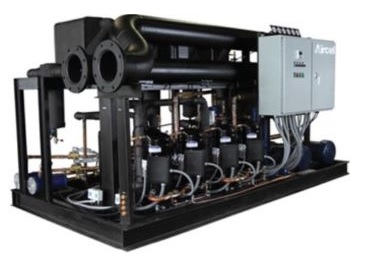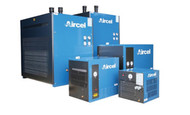A Comprehensive Buying Guide for Refrigerated Air …
Posted by AVP on Jul 4th 2022
Did you know that water vapor is present in the atmosphere at all times? Compressing air results in a higher concentration of water. It is necessary to treat the compressed air in order to prevent any potential issues with the compressor setup.
In certain cases, it's preferable to work with dry air, and the presence of moisture in compressed air may make it impossible. Dryers are a typical option that is used for the process of eliminating moisture content.
When it comes to typical industrial plant air applications, the refrigerated air dryer is a popular choice due to its ability to achieve a dew point that is suitable for usage. In this piece, we'll discuss the process of air drying using a refrigerated air dryer.
To What End Do Air Dryers Serve?
By eliminating moisture from compressed air, air dryers help keep the dew point down. Compressed air may contain moisture that, given the correct circumstances, may reach the dew point and condense into a hazardous liquid. It may compromise your products or machinery, lead to plumbing problems, create degradation, and other complications.
Refrigerated air dryers are the standard in most industrial compressed air systems. For these to function, heated compressed air is cooled using one or more heat exchangers, the water is condensed out, and the water is then drained automatically from the separator. If you're not in a particularly demanding environment and don't require an unusually elevated drying capacity, these dryers are a great, cost-effective option.
They are low-cost, straightforward, and need minimal upkeep. In other words, after you've purchased a high-quality model and had it expertly installed, you can essentially forget about it.
Just how does it function, exactly?
Compressed air dryers are devices that purify compressed air by removing liquids, water, water vapor, hydrocarbons, and hydrocarbon vapor.
For certain compressed air systems, the removal of moisture and water from the air is a problem. The incoming hot compressed air is cooled by the refrigerated air dryer as it passes through a heat exchanger.
There, the cold, dry air that exits the dryer is used to pre-cool the hot air that is coming in and remove part of the moisture from it. This procedure results in the condensation of the moisture into liquid water, which may then be drained away.
To prevent condensation on the external pipes, the exhaust air is warmed in a heat exchanger before being released. The high-pressure gas refrigerant is pumped into the condenser from the refrigeration compressor, where its latent heat is dissipated into the surrounding air as it condenses into a liquid state.
After that, the liquid refrigerant is metered into a frigid low-pressure zone where it eventually reaches the heat exchanger. Finally, low-pressure hot gas refrigerant is sucked into the refrigeration compressor, where it absorbs heat from the hot compressed air, and the cycle repeats.
Types of Refrigerated Compressed Air Dryers
Non-Cycling Refrigerated Compressed Air Dryer
When you switch on a non-cycling refrigerated air dryer such as the Aircel VF Series, the refrigeration compressor begins running and continues until you turn off the dryer.
In situations where full capacity operation is required, they may be a cost-effective alternative to cycle dryers. However, issues may arise when the demand for compressed air is minimal.
When it comes to flow rates ranging from 10 to 2,000 scfm, the Aircel VF Series is your best bet for maximum efficiency in a space-saving package. The VF Series dryers are the only ones on the market that can operate at the efficiency levels attained when the flow rate shifts.
The dryers of the VF Series use the unique Variable Flow heat exchanger to provide consistent dew point performance over a wide range of flow rates. Other dryers using mechanical moisture separators often suffer performance degradation when the compressed airflow velocity approaches or departs significantly from the nominal design point.
Most households choose non-cycling models since they are tried-and-true and need nothing in the way of upkeep.
Cycling Refrigerated Air Dryer
Refrigerated dryers that operate on a cycling system feature refrigeration systems that are activated only when the appliance requires cooling and are deactivated when it is not required.
Using less compressed air or having a colder environment will reduce the workload on the refrigeration compressor and condenser fan motor, resulting in lower energy consumption and longer life for the equipment. It's possible to rack up significant savings on one's power bill by using high-capacity cycling dryers.
Drying efficiency in the AES Series is maximized by perfectly matching input power with intake air demand. AES dryers save money on electricity and energy because of their ability to turn on and off the refrigeration compressor automatically.

The AES Series can adapt to the changing needs of your plants as time goes on. Modular units may be customized in 500 and 1,000 scfm intervals to perfectly meet your air flow needs from 10% to 100%, hence increasing drying power.
The cycle dryer's cooling capability increases or decreases based on air consumption. Using less energy means less money out of your pocket.
Air Dryer Buying Tips
The air compression system's maximum capacity is a key factor in determining which air dryer is best for your needs. Typically, the horsepower used to compress the air is multiplied by four to provide an approximation of the capacity in standard cubic feet per minute at 100 PSIG.
If you know the minimum and maximum working pressure of your system, you can choose the appropriate air dryer for your requirements. With each increase in pressure over 100 PSIG, capacity decreases by 1%. In order to alleviate stress on the compression system, increasing the pressure also lowers the moisture load.
Air consumption is an important component to consider while selecting the appropriate dryer for a given application and setting. A refrigerated drier, which creates air with a relative humidity of 10 to 20 percent, is suitable for most applications.
Choose Air Vacuum & Process Inc. for Air Dryers and Compressors
When it comes to air compressors and air dryers, AVP has you covered. Whatever it is you're looking for, we can provide it.
You can be certain that when you buy from us, you're obtaining only the highest quality items and equipment from manufacturers we've researched and found to be reliable.
Shop our variety of air compressors, air dryers, and other breathing air systems online, and feel free to get in touch with any questions you have or to get a free quote at your convenience.
